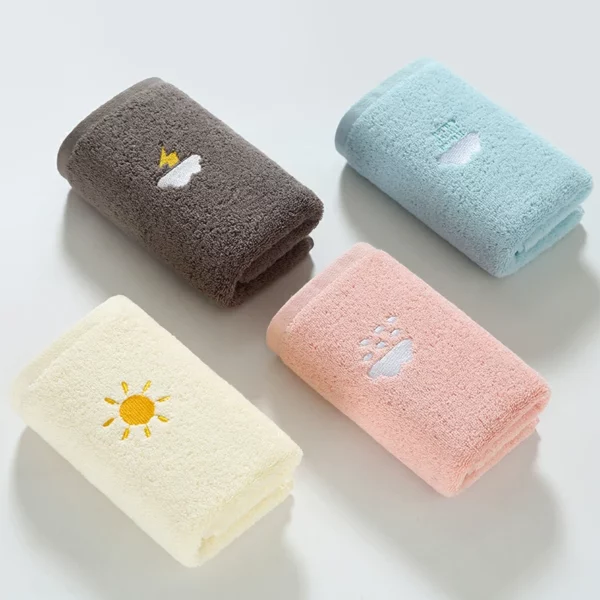Cotton terry cloth towels are typically absorbent and soft, but to impart waterproof properties, synthetic materials or treatments are often added.
Some types of synthetic fabrics known for their waterproofing characteristics in cotton terry cloth towels include:
- Polyurethane (PU) Coating:
- Polyurethane is a synthetic material commonly used as a coating on the backside of cotton terry cloth towels to make them waterproof. The PU coating creates a barrier that prevents water from penetrating the fabric while still allowing the cotton fibers to absorb moisture from the surface.
- Vinyl Backing:
- Towels with a vinyl backing are often considered waterproof. Vinyl is a synthetic material that provides a water-resistant barrier, making the towel suitable for various applications where protection from moisture is essential.
- Microfiber with Waterproof Membrane:
- Microfiber towels may be treated with a waterproof membrane or coating to enhance their water resistance. Microfiber itself is known for its absorbent properties, and when combined with a waterproof layer, it can prevent water from passing through.
- Nylon or Polyester Layer:
- Towels featuring a layer of nylon or polyester on the backside can exhibit enhanced waterproofing. These synthetic materials are naturally water-resistant, and when incorporated into the towel design, they can help repel liquids.
- Waterproof Fabrics (e.g., Polyester/Polyurethane Blends):
- Towels made from blends of polyester and polyurethane or other waterproof fabrics can provide effective water resistance. These blends are engineered to repel water and are often used in outdoor or high-moisture environments.
- PUL (Polyurethane Laminate):
- PUL is a laminated fabric that consists of a layer of polyurethane film bonded to a layer of fabric, often polyester. PUL is widely used in cloth diapering and similar applications due to its waterproof properties. Towels with PUL backing can offer effective waterproofing.
- Nanotechnology-Treated Fabrics:
- Advancements in nanotechnology have led to the development of fabrics with nano-sized coatings that provide water repellency. cotton terry cloth towel Towels treated with such nanotechnology can resist liquid absorption to a certain extent.
- Water-Repellent Finishes:
- Towels may be treated with water-repellent finishes or coatings that create a hydrophobic surface. These finishes, often applied to synthetic fibers, help beads water and enhance the towel’s resistance to moisture.
When choosing cotton terry cloth towels with waterproof properties, it’s essential to check the product specifications or labels for information on the materials used and any specific waterproofing treatments applied. Keep in mind that while these synthetic additions provide water resistance, they may also affect the towel’s breathability to varying degrees. Additionally, proper care instructions should be followed to maintain the waterproofing features over time.
Are the materials environmentally friendly or recyclable?
The environmental friendliness and recyclability of materials used in waterproof cotton terry cloth towels depend on the specific synthetic fabrics and coatings employed.
Here are considerations for different materials:
- Polyurethane (PU) Coating:
- PU is a synthetic material that, in its traditional form, is not biodegradable. However, there are environmentally friendly variations of PU coatings, such as water-based or solvent-free options, which may have lower environmental impact. Check product details or labels for information on the type of PU coating used.
- Vinyl Backing:
- Vinyl, also known as PVC (polyvinyl chloride), is generally not considered environmentally friendly due to concerns related to its production and disposal. PVC is not easily recyclable, and alternatives like PEVA (polyethylene vinyl acetate) may be preferred for more eco-friendly options.
- Microfiber with Waterproof Membrane:
- Microfiber itself is often made from synthetic materials, and while it can be durable and long-lasting, its environmental impact depends on the specific composition. The waterproof membrane may introduce additional synthetic elements. Look for microfiber towels made from recycled materials or those produced using eco-friendly practices.
- Nylon or Polyester Layer:
- Nylon and polyester are synthetic materials derived from petrochemicals. While they are not biodegradable, they are recyclable. Towels made from recycled nylon or polyester contribute to reducing the environmental impact associated with raw material extraction.
- Waterproof Fabrics (e.g., Polyester/Polyurethane Blends):
- Similar to nylon and polyester, these fabrics may not be biodegradable but can be recyclable. Towels made from recycled polyester or with eco-friendly production practices are more environmentally conscious options.
- PUL (Polyurethane Laminate):
- PUL typically involves a layer of polyurethane film laminated to a fabric. Like PU coatings, the environmental impact can vary depending on the type of PUL used. Water-based or solvent-free PUL options are considered more environmentally friendly than traditional alternatives.
- Nanotechnology-Treated Fabrics:
- Nanotechnology treatments may involve coatings with varying environmental impacts. Some nanotechnology applications can be designed to be eco-friendly, while others may involve materials with potential environmental concerns. Check product information for details.
- Water-Repellent Finishes:
- Water-repellent finishes can include various chemical treatments. Some finishes may be more environmentally friendly than others. Look for products with finishes that are free from harmful chemicals or have eco-friendly certifications.
In general, for environmentally conscious choices, consider towels made from recycled materials, those with certifications like OEKO-TEX® or bluesign®, or options explicitly labeled as eco-friendly or sustainable. Additionally, check with local recycling facilities to determine the recyclability of specific materials, as recycling capabilities may vary by location. Proper disposal methods and recycling efforts contribute to reducing the environmental impact of synthetic materials.
